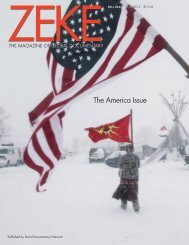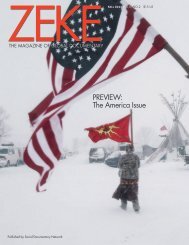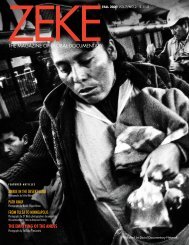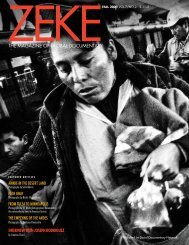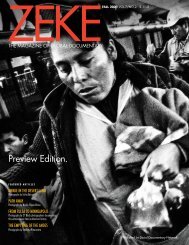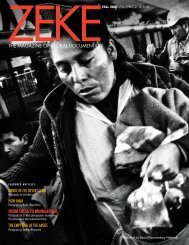ZEKE Fall 2019
Contents includes: "Youth of Belfast" by Toby Binder, and "Delta Hill Riders" by Rory Doyle, winners of ZEKE Award for Documentary Photography "Rising Tides" with photographs by Sean Gallagher, Lauren Owens Lambert, and Michael O. Snyder "Out of the Shadows: Shamed Teen Mothers of Rwanda" by Carol Allen Storey Interview with Lekgetho Makola, Head of Market Photo Workshop, South Africa, by Caterina Clerici "Why Good Pictures of Bad Things Matter" by Glenn Ruga Book Reviews and more...
Contents includes:
"Youth of Belfast" by Toby Binder, and "Delta Hill Riders" by Rory Doyle, winners of ZEKE Award for Documentary Photography
"Rising Tides" with photographs by Sean Gallagher, Lauren Owens Lambert, and Michael O. Snyder
"Out of the Shadows: Shamed Teen Mothers of Rwanda" by Carol Allen Storey
Interview with Lekgetho Makola, Head of Market Photo Workshop, South Africa, by Caterina Clerici
"Why Good Pictures of Bad Things Matter" by Glenn Ruga
Book Reviews and more...
- No tags were found...
Create successful ePaper yourself
Turn your PDF publications into a flip-book with our unique Google optimized e-Paper software.
Black<br />
The American West<br />
has been endlessly mythologized,<br />
and of its many myths, one of<br />
the most enduring is the idea of<br />
the West as a space for white<br />
Euroamericans. Indigenous peoples,<br />
Mexican Americans, and<br />
Asians all existed in the West, but<br />
in popular memory and culture<br />
their presence is either missing<br />
or heavily circumscribed. Like the<br />
West, “cowboy” has taken on<br />
an image all its own: it evokes<br />
a white man on horseback, probably<br />
between 1870 and 1890. Of<br />
those missing groups, however, one<br />
is especially conspicuous: the African<br />
American cowboy. In a February<br />
2017 issue of Smithsonian Magazine,<br />
journalist Katie Nomjimbadem<br />
estimated that as many as one in four<br />
cowboys was black.<br />
Enslaved Cowboys<br />
Before the United States had declared<br />
its independence from Great Britain,<br />
enslaved persons were working as<br />
cowhands and ranchers in parts of<br />
the Carolinas. Even before emancipation<br />
and the end of the Civil<br />
War, enslaved persons worked as<br />
cowboys in parts of the American<br />
South. Once Texas was added to<br />
the union, enslaved persons working<br />
as cowboys became normal there.<br />
Historian Peter Wood notes that some<br />
plantation owners went so far as to<br />
request new slaves from the Gambia<br />
River region in Africa because they<br />
were accustomed to working with<br />
cattle. Enslaved cowboys were often<br />
treated better than people working<br />
cotton in part because their skillset<br />
was more specialized and they were<br />
not easily replaced. They had access<br />
to better food, though they remained<br />
in bondage and were traded much<br />
like the livestock they saw after.<br />
24 / <strong>ZEKE</strong> FALL <strong>2019</strong>









